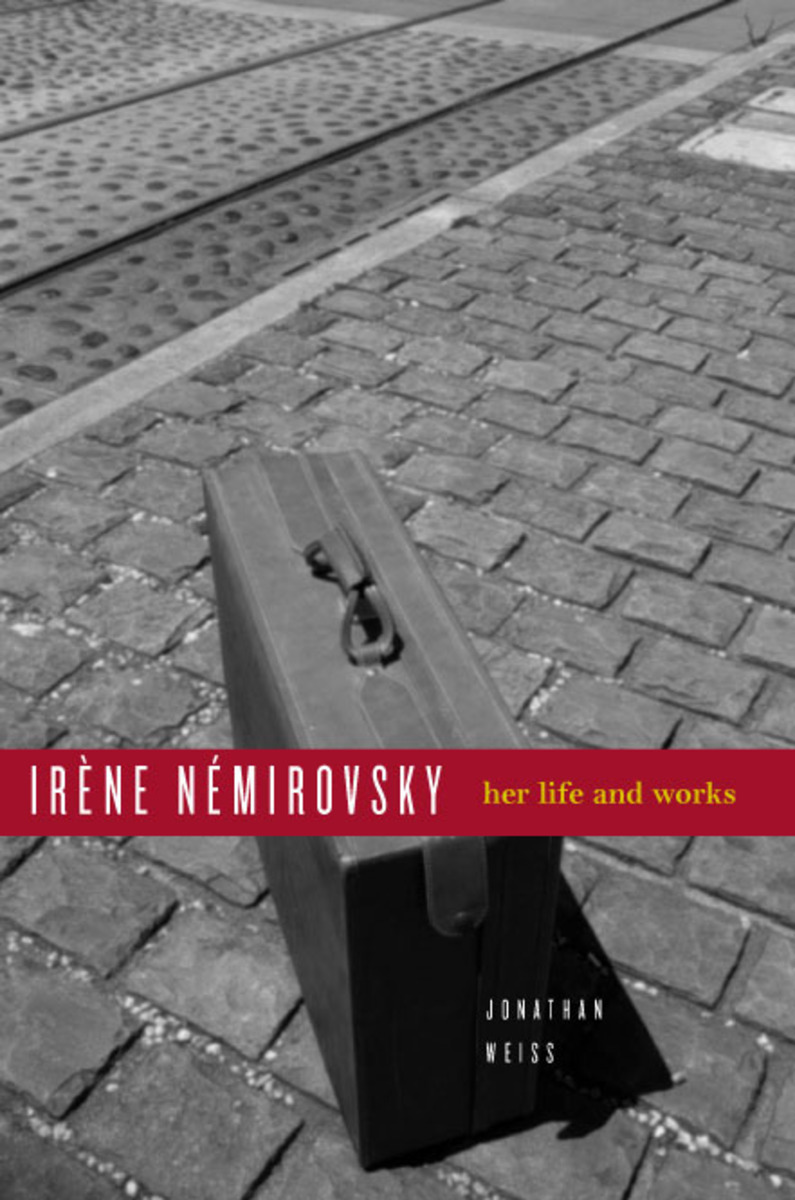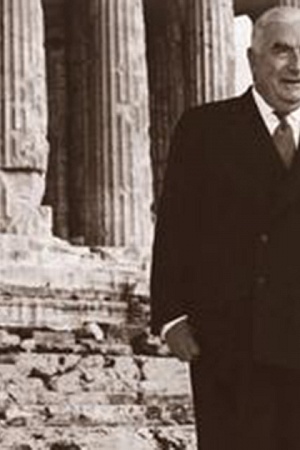David Golder
Vintage, $27.95 pb, 159 pp
David Golder by Irène Némirovsky & Irène Némirovsky by Jonathan Weiss
When Irène Némirovsky’s Suite Française was first published in France in 2004, it created extraordinary interest for at least three reasons. Firstly, there was the story of the survival of the manuscript, preserved in an unopened suitcase for almost sixty years by Némirovsky’s daughters, Elisabeth and Denise, who had assumed that the papers in their possession were personal notes that would be too painful for them to read. Secondly, there was the documentation, provided in Myriam Anissimov’s preface and in a rich appendix, about Némirovsky’s life as an identified foreign Jew under Nazi occupation. Arrested in July 1942, interned in the Pithiviers camp, and deported almost immediately to Auschwitz, she died barely a month after her arrest, even as her husband and friends, ignorant of her fate, tried frenetically to save her. Finally, there was the novel itself, or rather, the two completed sections of what was intended to be a five-part epic narrative: a brilliantly rendered fresco of the French collapse in 1940 and the first years of German occupation, which earned Némirovsky, posthumously, the unparalleled honour of the prestigious Renaudot prize. With the English translation of the novel in 2006, she became an international celebrity. A Némirovsky biography, therefore, could hardly be more timely.
Jonathan Weiss, who teaches French studies at Colby College in Maine, is at pains to stress that his interest in Némirovsky and her work pre-dated the Suite Française phenomenon by a number of years. By 2001 he had completed a book-length study in French of the author, but it was only in the wake of Suite Française that he found a publisher. Expanding his work to take Suite Française into account, he brought out the French version of his study in 2005. The English-language version, an elegant translation by Weiss’s wife, Dace, not only offers insight into Némirovsky’s life and career, it provides a useful basis for approaching the rather stormy international debate that has been stirred up around her.
In the main, Weiss’s book has been well received in France. It has also provoked a certain amount of resentment. Valérie Marin La Meslée, in Le Point (7 July 2005), noted that two French authors, Olivier Philipponnat and Patrick Lienhardt, both Némirovsky specialists, were preparing a biography that would certainly be richer than Weiss’s, and less flawed in its approach and methodology. Sour grapes towards an American ‘outsider’? Probably, at least to an extent. Weiss is quite frank about the limited amount of biographical archival material available to him, which has led him to concentrate most of his analysis on Némirovsky as a writer. At the same time, he has been thorough in his scrutiny of the contemporary press and of surviving correspondence. Weiss comes across as a practised and confident literary critic, and his analysis of the recurring motifs and themes in Némirovsky’s work sheds light on her life and mental world.
Born in 1903 into a wealthy and socially privileged Jewish family in tsarist Russia, Irène Némirovsky emigrated to France with her family in 1919, fleeing the revolution. Like many Russians of her class, she was already fluent in French, and she seems to have determined from an early age to leave behind both her Jewish and her Russian identities, electing France as the cultural space within which she would define herself, and French as the language in which she would construct her career as a writer. A dilatory but eventually successful Sorbonne student, she married Michel Epstein, a banker and fellow émigré, in 1926. Her first publications date from that time, but it was in 1929, with the publication of David Golder, that she became famous. The deep ambiguities associated with this work – a cruel but strangely moving portrait of a Jewish speculator – cast a darkening shadow over Némirovsky’s subsequent itinerary. Weiss traces Némirovsky’s prolific career through the 1930s, when she published a new novel almost every year as well as maintaining a steady output of short stories. In addition, she completed a number of works that would be published only after her death. This was a woman for whom writing was life. Neither her marriage nor the birth of her two daughters impinged on her commitment to writing, although she appears to have been a dutiful mother and wife – at least she did not neglect her family in the way she had been neglected by her own mother. She did well out of her profession, her royalty earnings and advances easily outstripping the income of her banker husband. Weiss rightly worries over the alliances that Némirovsky made among writers of the extreme political right, such as Paul Morand and Jacques Chardonne, as well as with the publisher Horace Carbuccia. She seems to have been largely blind to how dangerous the situation was becoming for Jews in France, especially for those who, like the Epsteins, had not taken French citizenship. Just why Némirovsky and her husband did not do so remains a mystery: Weiss hypothesises that it may have been simple neglect, based on the levels of safety that they felt. When, after the Munich Accords in 1938, they finally lodged an application, it met with ominous silence. Whether her subsequent baptism into the Catholic Church was intended as some kind of insurance against possible future persecution remains moot. For Weiss, it corresponded to an affinity with the deeper values she identified in French culture, a way of assuaging her discomfort with her Jewish background, and of belonging more fully to her chosen new homeland.
Whatever its motive, the conversion did her no good. When war broke out, Némirovsky and her family moved from Paris to the Burgundy village of Issy-l’Evêque, still in the occupied zone. Here, they suffered from increasing material hardship, even though Némirovsky still received some income from her publishers, and even though, through the connivance of the editors of the collaborationist periodicals Candide and Gringoire, she managed to continue publishing her work under pseudonyms. When the wearing of the yellow star became obligatory for all Jews in the spring of 1942, Némirovsky and her family complied. It made her an easy target for the French gendarmes carrying out Prime Minister Laval’s order to expel all foreign Jews aged between sixteen and fifty-five. When she was taken, and when she died in deportation just a month later, Némirovsky was just thirty-nine. In October 1942 Michel Epstein, too, was arrested, deported and probably gassed. The two little girls, one of them twelve, the other four and a half, were successfully hidden, and survived.
Weiss shares his sense of frustration about the choices that Némirovsky failed to make. She could have sought exile in the unoccupied zone (or even in the United States). The problem was that she believed she was better connected than she was, and this illusion, and the complacency that attended it, contributed to her arrest, deportation and death. As the trap of anti-Jewish measures inexorably closed around her – forbidding publication, the operation of bank accounts and indeed any form of public activity – Némirovsky became resigned and fatalistic. It is touching that her final completed work was a life of Chekhov, whose masterly end-of-era melancholy so profoundly corresponded to her own. She had lost some of her illusions about the France that had given her the freedom to castigate her origins but did not allow her to escape them.
After Némirovsky’s arrest, a large number of people participated in the efforts to free her, but no one seems to have been aware of the swiftness of the processes that had been set in train. It is poignant to realise that many of the letters seeking information and assistance were written after she was dead. Jonathan Weiss concludes that Némirovsky has her place in the long tradition of French moralist writers, fierce in her condemnation of a society driven by money and material rapaciousness, and desperate for a social order founded on love.
Weiss’s biography would have benefited from an index, but it is an informative work, neatly structured to bring out the dramatic and tragic fate of a woman who, as he puts it, ‘died without ever having resolved the question of where she belonged’. It is a book well worth reading. Whether it is entirely convincing, however, is another question. Although the author’s exploitation of the material available at the Institut Mémoire de l’Edition Contemporaine has been exemplary, he himself admits the paucity of his archival sources, and some of the historical background feels rather thin. For instance, we learn very little about people such as Hélène Morand, to whom Némirovsky turned for help. More importantly, Weiss’s treatment of the issue of whether Némirovsky was an anti-Semitic Jew, while better rounded than many of the discussions that have appeared in the international press, is not sufficiently grounded; and his contention that she was a great writer – or rather, that she deserves to be treated as one because Suite Française, had it been finished, would have been ‘one of the most important works of literature produced in twentieth-century France’ – remains assertion rather than argued analysis.
The question of Némirovsky’s anti-Jewishness has been brought to the fore by the republication of David Golder, the novel that made her reputation in 1929. Many commentators have pointed out that this publication is opportunistic, an effort to cash in on the international success of Suite Française, but it has also triggered debate over whether its subject matter constitutes anti-Semitism on the part of the author. Much of the book’s original success was due to its reception among the anti-Semitic, nationalist right, for whom its appeal was its savage ‘insider’ portrayal of the money-hungry, ruthless milieu of France’s Russian Jewish immigrant population. It is clear enough that Némirovsky had little affection for this world which she knew well, having grown up in it. But she herself stated in 1939 that she would not have written the work had she known about the way that events would evolve after Hitler’s rise to power. Another matter that has been held against her is the letter she wrote to the head of state, Marshal Pétain, seeking special treatment on the grounds that, although Jewish, her work had never favoured the Jews. However, while certainly not noble, this plea is clearly born of personal desperation and not of any racist belief.
It was therefore more by accident than by design that Némirovsky contributed to the increasingly virulent currents of anti-Semitism in interwar France. As Patrick Marnham puts it in his introduction to Sandra Smith’s new translation, ‘Golder is Jewish because Némirovsky was Jewish, but her choice of an unsympathetic Jewish character did not make Némirovsky anti-Semitic any more than Robert Louis Stevension was anti-Scottish because he created the diabolical figure of Ebenezer in Kidnapped’. Her novel was praised for its realism (and not infrequently compared to Balzac), and it was this quality that inspired Julien Duvivier to turn it into his hugely successful film of the same name in 1930. Still, in provoking distressed anger from the Jewish press and rave reviews from the nationalist right, David Golder planted Némirovsky squarely on one of France’s most critical seismic fault-lines, a position from which, despite her best efforts, she would never escape.
But for a couple of episodes, David Golder would be a slight work, more an extended short story than a fully fledged novel. The three main characters – Golder himself, his wife Gloria, and his daughter Joyce – are stereotypes living stereotypical lives. Golder is a businessman in his late sixties who has pulled himself up out of poverty and made a fortune, mainly in oil speculation. Gloria seemingly exists entirely to leech Golder’s money from him in order to drape herself in expensive clothing and jewellery, and to maintain an opulent lifestyle in Paris and Biarritz. Their daughter Joyce follows in her mother’s footsteps: at eighteen years old, she is a vacuous socialite, motivated only by an insatiable desire for champagne, fun and amorous adventures with the fortune-seeking types who hang around such families. The work opens dramatically, when a cold-hearted decision by Golder drives an old friend and associate to suicide:
‘No,’ said Golder, tilting his desklamp so that the light shone directly into the face of Simon Marcus who was sitting opposite him on the other side of the table. For a moment Golder observed the wrinkles and lines that furrowed Marcus’s swarthy face whenever he moved his lips or closed his eyes, like the ripples on dark water when the wind blows across it.
Némirovsky keeps the story ticking over with crisp descriptions and rapid, almost cinematographic, changes of scene.
What gives it substance is that Golder, despite lucid awareness of his daughter’s frivolity and her lack of any real affection for him, loves her more than his own life. Indeed, he finally sacrifices himself to provide her with the money that she craves and will certainly waste. This graver tone in the novel hinges on two parallel travelling sequences, one a railway journey from Paris to Biarritz early in the work, and the other a boat journey out of Russia, towards the end of the novel, when Golder has returned there to make one last major deal. In these sequences, Golder suffers the heart attacks that will eventually kill him. The experience is described from the inside as the protagonist suffers both the physical pain and the psychological anguish springing from his fear of death. The writing in these sections is riveting, achieving a simultaneous and disturbing effect of oppression and compassion. Its intensity, set as it is in the context of a journey whose destination may not be reached, strongly suggests that beyond the satirical realism of her plot, Némirovsky was giving potent voice to her own existential uncertainties.
The issue of Némirovsky’s writerly status cannot be resolved. In France at least, she has never really been forgotten as fully as many commentators claimed at the time of the discovery of Suite Française: most of her more significant works have either remained in print or been republished. At the same time, she is not as great a novelist as Jonathan Weiss would like her to be considered. We need to remember that her contemporaries were the likes of André Malraux, Georges Bernanos, Marguerite Yourcenar, Jean-Paul Sartre, and Louis Ferdinand Céline. If David Golder undoubtedly pointed to talent and some depth, nothing that followed quite reached the same strength until Suite Française. The richness of its portrayal of France’s collapse in 1940 suggests that the author might have broken through into new ground, but it appeared too late to offer anything in the way of fresh understanding of those tragic events. Since World War II, scores of fictional narratives, both novels and films, have deployed the same essential elements that Némirovsky uses in her account. Her evocation of the great exodus of civilians from Paris is well rendered, for example, but no more so than in René Clément’s 1951 classic Jeux Interdits (Forbidden Games). Furthermore, there is no guarantee that, had she lived, Némirovsky would have actually completed her planned epic. After all, Sartre abandoned Les Chemins de la Liberté and Malraux, similarly, left Les Noyers de l’Altenburg incomplete, both writers being convinced that the war had destroyed the continuities they had been attempting to weave through their fiction. The best novelistic account of the French experience of World War II is in Céline’s last works, which are unremittingly apocalyptic.
In short, for those familiar with postwar French literature and cinema, Suite Française is not so much a revelation as a reminder. A salutary one, to be sure, because its message is one that needs to be constantly renewed: it shows how easy it is for a civilisation – even a great civilisation – to collapse into disarray and to betray its own most closely held values and principles. In the end, it is less as a writer than as an historical phenomenon that Irène Némirovsky will hold an important place in the French national memory.












Leave a comment
If you are an ABR subscriber, you will need to sign in to post a comment.
If you have forgotten your sign in details, or if you receive an error message when trying to submit your comment, please email your comment (and the name of the article to which it relates) to ABR Comments. We will review your comment and, subject to approval, we will post it under your name.
Please note that all comments must be approved by ABR and comply with our Terms & Conditions.